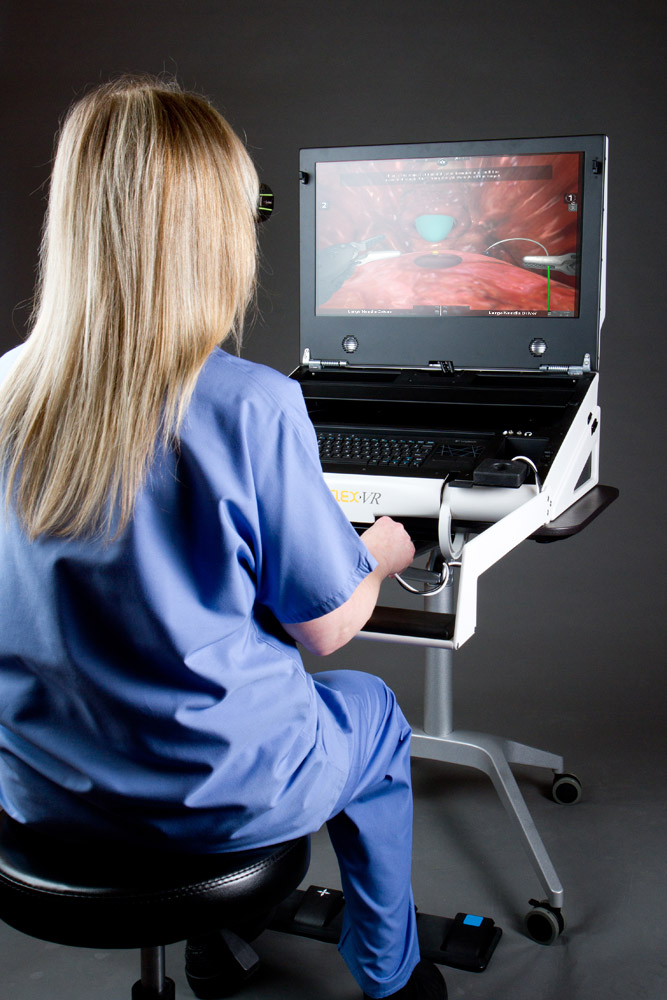Any technology brought into the OR to create new care pathways for surgical teams is also likely to bring with it a myriad of challenges. That dilemma is especially true of robotically-assisted surgical systems. They unquestionably transform the work of surgeons, but matters are complicated by the need to smartly, efficiently provide a way for physicians and other staff to train with the complex devices.
Mimic Technologies recognized the need for easier, more economical robotically-assisted surgical system training tools. One of the key innovations they’ve delivered is the FlexVR, an offering in their dV-Trainer product line that made a splash at the Society of Laparoendoscopic Surgeons MIS Week in the fall.
Jeffrey Berkely, CEO, founder, and chairman of Mimic Technologies, says the FlexVR allows for virtual reality training on the da Vinci, but with a key difference from other available devices that use technology to replicate the experience of operating with Intuitive Surgical’s flagship device.
“To date, most of the available simulators that emulate the da Vinci are based on the surgeon console, so they’re big,” explains Berkley. “They take up a lot of precious space in a hospital and can be difficult to move around.”
The FlexVR comes in a suitcase small enough to be easily checked in for a plane flight. Despite its compact size, the FlexVR has integrated controllers, foot pedals, a 3D monitor, glasses, a touchpad, and all the other components required to give users the complete sensation of being at the controls of a robotically-assisted surgical system.
Although Mimic Technologies has licensed its technology to Intuitive Surgical for training with the robot’s surgeon console, the FlexVR is designed to be used anywhere, including in the home. The theory is simple: The more accessible the training, the more people who can train and become proficient in robotically-assisted surgery before performing procedures on real patients.
The FlexVR expertly mimics the da Vinci, but future versions will be adapted for training associated with the array of competing robotically-assisted surgical systems expected to impact the marketplace soon.

(Image credit: Mimic Technologies)
In addition to improving patient safety by letting surgeons take trial runs with the virtual reality technology, the FlexVR can be a fiscal boon for hospitals. The cost per case increases when surgeons are less proficient with a tool due to longer case time and worse outcomes. The FlexVR helps physicians master the basic mechanics of the robotic device, allowing them to fully focus on surgical technique by the time they’re working with patients in the OR.
In developing training, the primary concern is usually around new surgeons, or at least practitioners who are less accustomed to a particular tool. But studies in the field suggest that simulations are just as important for surgeons trying to keep their skills honed for surgical scenarios that don’t come through the OR doors with great frequency.
The portability of the FlexVR helps facilities bypass one of the common problems that could dissuade surgeons from continuing education. When the training tool is difficult to access, such as a simulator attached to the surgical robot, it’s too easy to forgo skills maintenance in between surgeries.
“If your simulator is stuck in a busy OR, it can be challenging to get enough training,” argues Berkley.
There are over 150 exercises available on Mimic Technologies platforms, so nearly every challenge a surgeon might encounter is available as a simulation.
The portable device is also economically priced compared to large-scale simulators, which is key for hospitals and other healthcare facilities that have already laid out major dollars for purchase and installation of a robotically-assisted surgical system.
“With FlexVR, hospitals can aquire a training solution with a relatively small capital investment and then choose the software subscriptions that work best for their needs,” says Berkley. “Educators can choose from basic skills, advanced skills, and procedure training options. Curriculums can be customized in many ways to meet varying training objectives”
Procedures utilizing the da Vinci or other robotic systems still represent a relatively small portion of the caseload in the OR, about 10 percent of all laparoscopic cases, but that is sure to change.
“What we’re going to see is robotics taking over more and more and more of the minimally invasive surgery market,” Berkley says. “In the future, we are going to have a computer-mediated interface between surgeons and their patients, whether it’s a robot, whether it’s image-guidance, or some other technology.”
Mimic Technologies aims to help surgeons and healthcare facilities be fully ready for that future, no matter how quickly it arrives.




